
Paphiopedilum, often called the Venus slipper, is a genus of the lady slipper orchid subfamily Cypripedioideae of the flowering plant family Orchidaceae. The genus comprises some 80 accepted taxa including several natural hybrids. The genus is native to Southeast Asia, the Indian Subcontinent, southern China, New Guinea and the Solomon and Bismarck Islands. The type species of this genus is Paphiopedilum insigne.

Paphiopedilum armeniacum is a species of flowering plant in the orchid family, Orchidaceae. It is known commonly as the apricot orange paphiopedilum and golden slipper orchid. It is endemic to China, where it occurs only in Yunnan. It is also cultivated and has won prestigious awards at flower shows.
Paphiopedilum adductum is a species of plant in the family Orchidaceae. It is endemic to Mindanao Island of the Philippines. Its natural habitat is subtropical or tropical moist lowland forests. It is threatened by habitat loss and overcollection.

Paphiopedilum barbigerum is a species of flowering plant in the family Orchidaceae known commonly as the beard carrying paphiopedilum. It is native to China, Vietnam, and Thailand. It is an endangered species due to habitat destruction and overcollection for the horticultural trade.
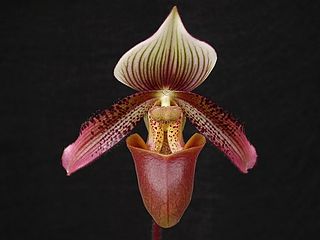
Paphiopedilum ciliolare is a species of flowering plant in the orchid family, Orchidaceae. It is known commonly as the short haired paphiopedilum. It is endemic to the Philippines.

Paphiopedilum dianthum is a species of flowering plant in the orchid family, Orchidaceae. It is native to China, Laos, and Vietnam. It is known commonly as the double flowered paphiopedilum.

Paphiopedilum fowliei is a species of plant in the family Orchidaceae. It is endemic to Palawan in the Philippines. Its natural habitat is subtropical or tropical moist lowland forests. It is threatened by habitat loss.
Paphiopedilum tigrinum is a species of plant in the family Orchidaceae. It is endemic to western Yunnan (China).

Paphiopedilum urbanianum is a species of plant in the family Orchidaceae. It is endemic to Mindoro in the Philippines. Its natural habitat is subtropical or tropical moist lowland forests. It is almost extinct in the wild, partly due to habitat loss, but even more so because of unsustainable collecting for the horticultural trade.

Paphiopedilum acmodontum is a species of plant in the family Orchidaceae. It is endemic to the Philippines.
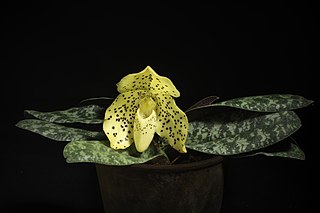
Paphiopedilum wenshanense is a species of Paphiopedilum in the subgenus Brachypetalum found in Wenshan Zhuang and Miao Autonomous Prefecture in Yunnan, China. The plant is found growing in densely shrubby and grassy slopes in limestone areas at elevations between 1000 and 1200 meters.

Paphiopedilum callosum is a species of orchid found from Vietnam to northwestern Peninsular Malaysia. It has been investigated and shown promising results in the treatment of cancer.
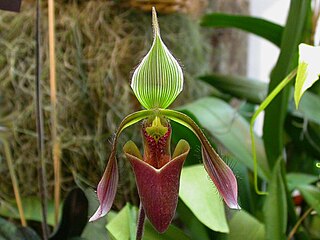
Paphiopedilum dayanum is a species of orchid endemic to Mount Kinabalu on Borneo.

Paphiopedilum haynaldianum is a species of orchid endemic to the islands of Negros and Luzon of the Philippines.

Paphiopedilum insigne is an Asian species of slipper orchid and the type species of the genus Paphiopedilum. Its name is derived from the Latin insigne, meaning 'badge of honor' due to the magnificent flower. In the 19th century it was very popular among European and American orchid growers, causing it to become very rare in the wild due to over collecting. There are many varieties of it and hybrids with it.

Dendrobium bullenianum is a member of the family Orchidaceae found in the Philippines and Vietnam. It is named in honor of Mr. Bullen, orchid cultivator with Low & Co.'s nursery, who was first in Britain get this species to flower in cultivation. It is pendulous and sympodial with 1 meter long pseudobulbs of 1.5 cm thickness and deciduous leaves of 10 cm by 1.5 cm. Heinrich Gustav Reichenbach was the first to describe this species in 1862 in Botanische Zeitung. It is found as an epiphyte in elevations up to 1,000 metres in Luzon and Mindoro in the Philippines.
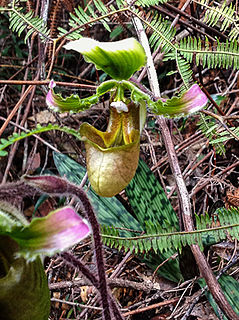
Paphiopedilum robinsonianum is a species of slipper orchid endemic to Sulawesi, Indonesia, where it is known from two mountains in the regency of Central Sulawesi. It is restricted to tropical montane forest habitat at approximately 1400 metres altitude.
Paphiopedilum wentworthianum is a species of orchid, endemic to the islands of Guadalcanal and Bougainville.
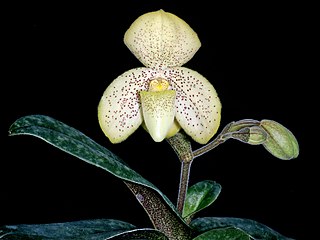
Paphiopedilum subgenus Brachypetalum is a subgenus of the genus Paphiopedilum.
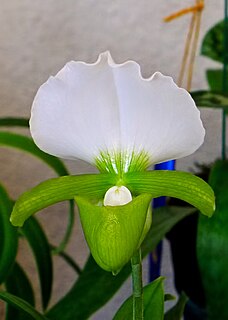
Paphiopedilum subgenus Paphiopedilum is a subgenus of the genus Paphiopedilum.


















